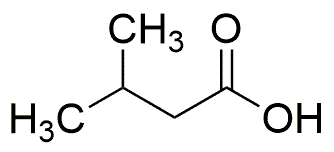Isovaleric acid is widely utilized in research focused on:
- Flavoring and Fragrance Industry: This compound is used as a flavoring agent in food products and as a fragrance in perfumes, providing a distinct aroma that enhances sensory experiences.
- Pharmaceuticals: It serves as an intermediate in the synthesis of various pharmaceuticals, contributing to the development of medications that target specific health conditions.
- Biochemical Research: Researchers utilize isovaleric acid in metabolic studies and as a substrate in enzymatic reactions, helping to understand metabolic pathways and enzyme functions.
- Agriculture: It is applied in the formulation of herbicides and pesticides, offering a natural alternative that can be effective against certain pests while being less harmful to the environment.
- Animal Feed: The compound is also used in animal nutrition, promoting growth and improving feed efficiency, which is crucial for livestock management in the agricultural sector.
General Information
Properties
Safety and Regulations
Applications
Isovaleric acid is widely utilized in research focused on:
- Flavoring and Fragrance Industry: This compound is used as a flavoring agent in food products and as a fragrance in perfumes, providing a distinct aroma that enhances sensory experiences.
- Pharmaceuticals: It serves as an intermediate in the synthesis of various pharmaceuticals, contributing to the development of medications that target specific health conditions.
- Biochemical Research: Researchers utilize isovaleric acid in metabolic studies and as a substrate in enzymatic reactions, helping to understand metabolic pathways and enzyme functions.
- Agriculture: It is applied in the formulation of herbicides and pesticides, offering a natural alternative that can be effective against certain pests while being less harmful to the environment.
- Animal Feed: The compound is also used in animal nutrition, promoting growth and improving feed efficiency, which is crucial for livestock management in the agricultural sector.
Documents
Safety Data Sheets (SDS)
The SDS provides comprehensive safety information on handling, storage, and disposal of the product.
Product Specification (PS)
The PS provides a comprehensive breakdown of the product’s properties, including chemical composition, physical state, purity, and storage requirements. It also details acceptable quality ranges and the product's intended applications.
Certificates of Analysis (COA)
Search for Certificates of Analysis (COA) by entering the products Lot Number. Lot and Batch Numbers can be found on a product’s label following the words ‘Lot’ or ‘Batch’.
*Catalog Number
*Lot Number
Certificates Of Origin (COO)
This COO confirms the country where the product was manufactured, and also details the materials and components used in it and whether it is derived from natural, synthetic, or other specific sources. This certificate may be required for customs, trade, and regulatory compliance.
*Catalog Number
*Lot Number
Safety Data Sheets (SDS)
The SDS provides comprehensive safety information on handling, storage, and disposal of the product.
DownloadProduct Specification (PS)
The PS provides a comprehensive breakdown of the product’s properties, including chemical composition, physical state, purity, and storage requirements. It also details acceptable quality ranges and the product's intended applications.
DownloadCertificates of Analysis (COA)
Search for Certificates of Analysis (COA) by entering the products Lot Number. Lot and Batch Numbers can be found on a product’s label following the words ‘Lot’ or ‘Batch’.
*Catalog Number
*Lot Number
Certificates Of Origin (COO)
This COO confirms the country where the product was manufactured, and also details the materials and components used in it and whether it is derived from natural, synthetic, or other specific sources. This certificate may be required for customs, trade, and regulatory compliance.


